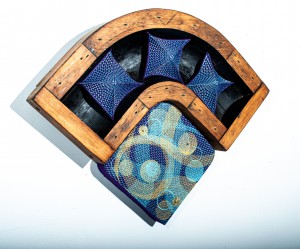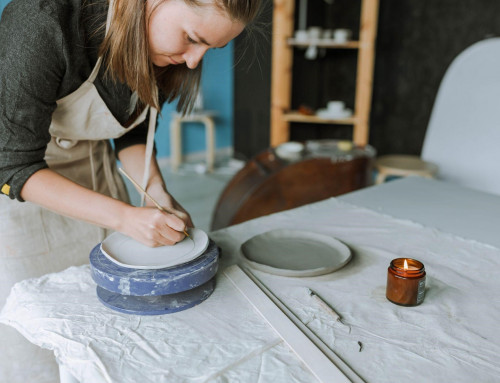Collecting Art… on a Budget?
And, why does art cost so much?
I love art. I make art and I sometimes wonder, too. I make art that I cannot easily afford!
Collecting Art on a budget. You and I see the news flashes about auction prices at 10’s of millions of dollars. You go to galleries and museums and see tiny, precious things, or huge piles of ordinary detritus and you wonder, ” What gives here?” I get asked questions from time to time.
When art is created, it is never priced at millions of dollars. Those auction prices that make the news are resale prices. Owners of the artwork sell what they own, hopefully at a profit. Sometimes estates are forced to sell artworks to fulfill tax obligations. If the piece is by an important artist…it will likely go to an auction house who will research the work and determine, based on its sales history, exhibition history, and condition whether it can sell at a profit. Museums do not often put artworks up for auction because of the limitations of their charters, terms of donation and codes of ethics. Galleries are interested in auctions and encourage their collectors to sell when the market is right as it can increase the value of other artwork by the same artist, secondarily increasing the potential profit margin on future sales. This is all about the rarefied art that can be considered an asset class!
That’s all very interesting, but that’s for the Picassos and Rembrandts!
“What about all that other work, you know, like $300 paintings or even $5,000 things?
How come they are so expensive? I can’t afford that. I have bills to pay and children to feed.”
Collecting Art on a budget. Well, I will attempt to address this conundrum. Art takes time and materials to make. Artists in galleries and at street festivals are professionals. Most of them have college degrees and student loans. Some have advanced degrees. Almost all artists work on speck, which means they make their work and hope to find a buyer. You need to have finished work in order to entice people to buy from you, even if they are commissioning you to make a super, spectacular piece. Would you buy a painting from someone whose artwork you have never seen? Aside from materials and time, there are costs to make sales.
The Costs of Street Fairs
The average art festival/street fair may have a fee of $200-$300 to rent a booth. You may have paid a non-refundable jury fee to compete for that booth. You have built or bought display fixtures to show your work, you have bought or rented weather protection, you have driven to the fair, you may have housing/camping/ hotel expenses as well as meals. So, let’s say your expenses just to show up for a two day, out of town fair are around $2000 up front. So, your sales have to cover that as well as your time and materials and turn a profit to invest in your business for the future. HMMM. How much do you make per hour in order to pay your bills and feed your children? Back in my art festival days I used a factor of 10 x my cost of goods to determine my prices, then I looked at the competition and adjusted up or down from there.
Also, not all art is appropriate for a street festival. There is lots of lovely, competent stuff at street fairs. Things you may love. But if you are an artist whose cost to make goods is high or whose artwork is challenging in someway, you may belong in a gallery.
The Costs of Selling in a Gallery
Artists generally pay a 50% commission on goods sold in a gallery, sometimes less. WHY? When you sell with a gallery, they, in the best of circumstances, are investing in you. They advertise and promote your work to their clients. They need to carry insurance, keep inventory, pay taxes, do all the administrative tasks you can imagine, write a lot, email a lot. They pay the costs of their physical facility and put in hours to make things happen for you. It’s a full time job. When you really think about it, it makes sense. HMMM. How much do you make per hour in order to pay your bills and feed your children?
What other costs might an artist have that effect their prices?
Well, artists are rarely just discovered. Artists need to work to be seen. That involves time and direct expense as well. Time to research where to show your work. Dollars to apply for competitions- there are non-refundable jury fees averaging about $45 now. I am very successful at getting shows, but my acceptance rate is about 50%. Artists are often required to pay packing and shipping to and from a show. Oh! and whether you are a street fair artist or a gallery artist, you gotta have superb photos of your work. You either have to own the equipment and train yourself or hire someone. And then there are the computer and computer skills to get all this information and images out there to interested parties. HMMM. How much do you make per hour in order to pay your bills and feed your children?
So, What’s an Artlover to Do?
How can an Average Person Collect Art?
Ah! There are ways!
Many artists make things they cannot afford to buy outright. And many artists have lovely art collections. How can that be?
- Well, it never hurts to ask if an artist will accept terms, paying over a several month period. The worst that will happen is they will say “no.” Many will say yes.
- Please don’t ask if they will take less! Their expenses haven’t changed since you first saw the work.
- It is also important that artwork be consistently priced. If the artwork is sold in a gallery and from the studio, the price should be the same or the gallery will drop the artist in whom they have invested time and money…and that artist may get blacklisted. So don’t go from the gallery to the studio and ask for a discount. It is offensive and risks the artist’s livelihood.
- Artists often trade with one another. What do you have to trade? a service? Are you a tax preparer? a photographer? a superb baker? a dentist? What skill or item of value can you offer?
- Buy when the art is affordable, like Herb and Dorothy Vogel.Read the amazing story of Herb and Dorothy Vogel! They were so committed to buying art that they devoted one of their incredibly modest incomes to doing just that! They lived in a small apartment and bought artwork from unknown artists because they loved it.







